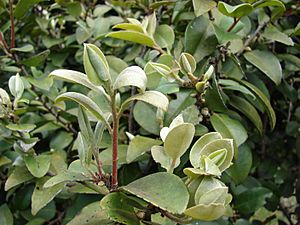Diospyros sandwicensis facts for kids
Quick facts for kids Diospyros sandwicensis |
|
|---|---|
 |
|
| Scientific classification | |
| Genus: |
Diospyros
|
| Species: |
sandwicensis
|
| Synonyms | |
|
Maba sandwicensis A.DC. |
|
The Diospyros sandwicensis is a special kind of flowering tree found only in Hawaii. It's often called lama by the Hawaiian people. This name also means "enlightenment" in the Hawaiian language.
The lama tree belongs to the same plant family as persimmons and ebony trees. It usually grows to be a small to medium-sized tree. It can be about 6 to 12 meters (20 to 40 feet) tall. Its trunk can be around 0.3 meters (1 foot) wide.
You can find lama trees in many different parts of Hawaii. They grow in dry, moist coastal areas, and even wet forests. They live at different heights, from near sea level up to about 1,220 meters (4,000 feet) high. You can spot them on all the main Hawaiian islands.
On islands like Maui, Molokaʻi, Kahoʻolawe, and Lānaʻi, lama trees are very common. They often grow alongside another tree called olopua (Nestegis sandwicensis). Together, they form important parts of the lowland dry forests.
What is the Lama Tree Used For?
The lama tree has two main parts to its wood. The outer part, called the sapwood, is very white. It forms a wide band inside the tree trunk. The inner part, called the heartwood, is reddish-brown. It has a fine texture and is very strong and hard.
Traditional Hawaiian Uses
Native Hawaiians used lama wood for many things. They made aukā, which were upright supports. These supports helped build hīnaʻi, a type of basket used for catching fish.
The white sapwood of the lama tree was very important in Hawaiian religious practices. It stood for enlightenment. For example, a special building called a hale lau lama was made using this white sapwood. Its posts (pou), thatching sticks (ʻaho), and rafters (oʻa) were all made from lama sapwood.
A pā lama was a fence built from lama sapwood. It created a special enclosed area. A block of the white sapwood was also used on the kuahu (altar) inside a hālau hula. This was a building where hula was performed. This block was covered in yellow kapa cloth and smelled like ʻōlena (Curcuma longa). It represented Laka, who is the goddess of hula.
Besides its wood, the lama tree also produces small berries called piʻoi. These berries are safe to eat.
Gallery
See also
 In Spanish: Diospyros sandwicensis para niños
In Spanish: Diospyros sandwicensis para niños






